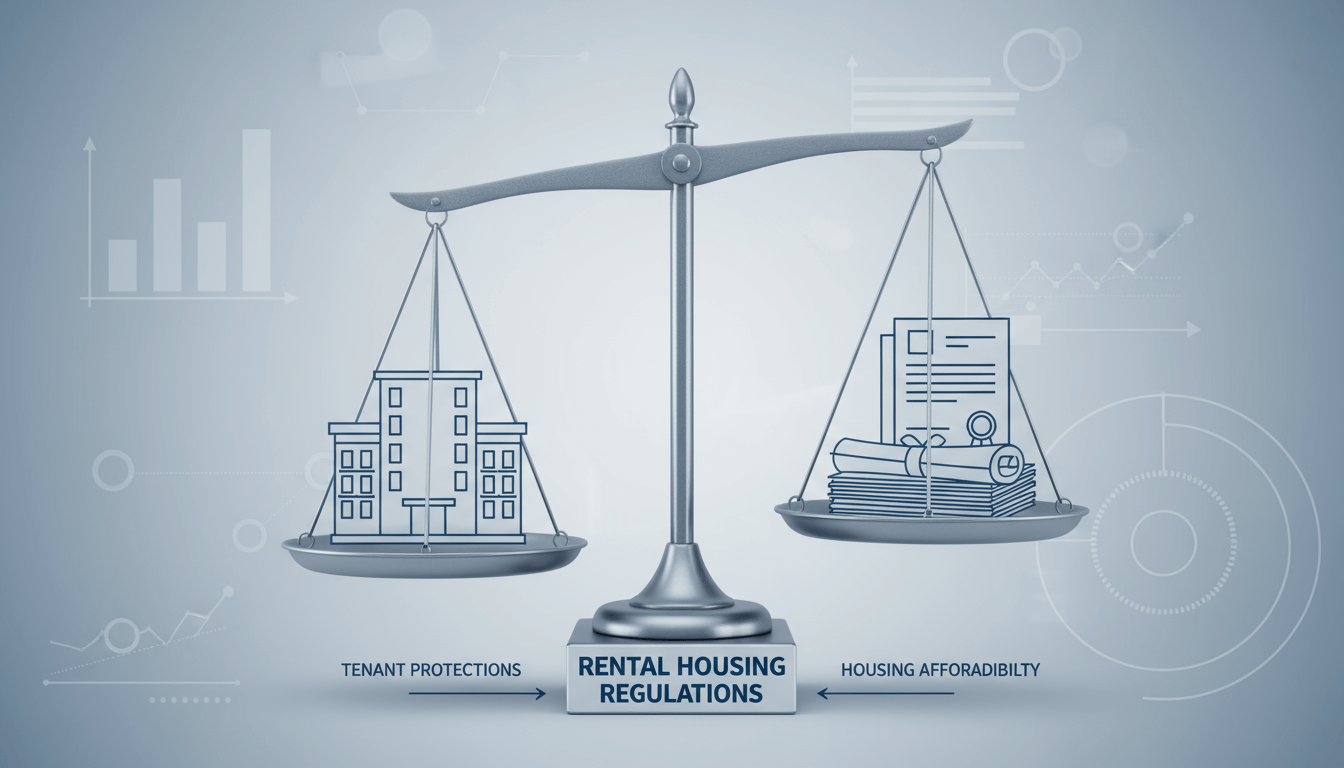Rental Housing Regulations Impact on Affordability | LAA Members Research
The Hidden Cost of Protection: How Rental Regulations Impact Affordability
The Paradox Housing Providers Face Daily
As apartment association members, you witness it firsthand: regulations designed to protect renters are making housing less affordable for the very people they aim to help. It's the kind of paradox that keeps property managers up at night and frustrates residents who see their rent climbing despite good intentions from policymakers.
New research from housing economists Daniel Shoag, Ph.D., and Issi Romem, Ph.D., published in September 2025, quantifies what many in our industry have long suspected. Their study, "Regulation and Rents," provides hard data on how well-meaning rental housing regulations translate into measurable rent increases—particularly for lower-income households and smaller properties.
The findings aren't just academic. They represent real dollars impacting your operations and your residents' ability to afford quality housing.
The Research: 24 Years of Data Across 391 Markets
The study analyzed rental data from 2000 to 2024 across 391 U.S. metropolitan areas, examining four major categories of rental housing regulations:
-
Source-of-income protections (laws preventing discrimination based on housing vouchers or other income sources)
-
Resident screening restrictions (limitations on background and credit checks)
-
Eviction regulations (rules governing the eviction process)
-
State preemption laws (state-level restrictions on local rental regulations)
Using both market-level data from CoStar Group and household-level data from the American Community Survey, the researchers isolated the impact of each regulation type on rental prices while controlling for other market factors.
The Numbers: What Regulations Actually Cost Renters
Here's where the research gets uncomfortable for everyone involved in housing policy. The rent increases are substantial and measurable:
Individual Regulation Impacts
Source-of-Income Laws
-
Increase rents by 5.2-5.3%
-
Translates to $876-$1,104 more per unit annually
Eviction Regulations
-
Increase rents by 5.9-6.5%
-
Costs renters $1,092-$1,224 more per unit each year
Resident Screening Restrictions
-
Increase rents by 1.5-3.4%
-
Adds $252-$708 annually per unit
State Preemption Laws
-
No statistically significant impact on rents
Combined Effect: The Cumulative Burden
When markets have multiple regulation types in place (as many urban areas do), the combined impact reaches 8.6-9.0% higher rents—approximately $1,451-$1,867 more per unit annually.
Critically, these increases aren't simply additive because policies tend to cluster in similar markets. But the cumulative burden on affordability is undeniable.
Who Pays the Highest Price?
The research reveals two groups disproportionately affected by these regulatory rent increases:
Lower-Income Renters Bear the Greatest Burden
Across all three categories of rental housing ordinances, lower-income renters experienced larger rent increases than their higher-income counterparts. In some cases, renters in the lowest income quartile faced increases of up to 7.4%—significantly higher than average impacts.
This creates a cruel irony: regulations intended to protect vulnerable renters often make housing least affordable for those who can least afford it.
Small Multifamily Properties See Largest Increases
Residents of properties with two, three, and four units consistently faced the largest rent increases across all regulation categories. These smaller properties—often owned by individual investors or small property management companies—have less capacity to absorb increased compliance costs and administrative burdens.
For LAA members managing smaller portfolios, this finding likely resonates with your operational reality.
Why Do Regulations Increase Rents?
This research builds on the authors' February 2025 report, "Behind the High Cost of Rent," which demonstrated that rental housing regulations raise the costs of providing multifamily housing. Here's how:
Increased Administrative Costs
-
Additional paperwork and compliance requirements
-
Legal consultation and risk management expenses
-
Staff time dedicated to navigating complex regulations
Higher Risk Premiums
-
Reduced ability to screen tenants increases financial risk
-
More restrictive eviction processes extend non-payment periods
-
Property owners factor these risks into pricing
Reduced Operating Efficiency
-
Longer vacancy periods due to screening restrictions
-
Extended resolution times for problem tenancies
-
Increased legal costs when disputes arise
Market Distortions
-
Some property owners exit the rental market entirely
-
Others convert units to condominiums or short-term rentals
-
Reduced supply further pressures rental prices upward
Recent industry data supports these mechanisms: 17% of rental property owners identified compliance with local regulations and tenant protection laws as one of their biggest challenges in 2024.
The Policy Dilemma: Protection vs. Affordability
This research doesn't argue that rental housing regulations are inherently bad. Many provide critical protections for residents facing discrimination, unfair screening practices, or improper evictions. These safeguards serve important fairness and stability goals in rental housing markets.
However, the data makes clear that these protections come with real affordability costs—costs ultimately borne by renters, especially those with limited incomes.
As housing affordability reaches crisis levels nationwide, policymakers face difficult choices. The researchers note: "While these regulations offer critical safeguards for residents, they also increase the cost of providing rental housing."
What This Means for Apartment Association Members
For LAA members, this research provides evidence-based talking points when engaging with policymakers, community stakeholders, and residents about regulatory impacts:
1. Lead with Data, Not Anecdotes While your operational experiences matter, research-backed numbers carry weight in policy discussions. These findings give you quantifiable impacts to reference.
2. Acknowledge the Trade-offs Effective advocacy doesn't dismiss tenant protections—it asks how we can achieve protection goals with minimal affordability impacts. The conversation shouldn't be whether to protect renters, but how to do so most efficiently.
3. Focus on Lower-Income Impacts The disproportionate burden on lower-income renters strengthens the case that current approaches need refinement. Both property owners and tenant advocates should share concern about policies that hurt those they're meant to help.
4. Highlight Small Property Challenges If you manage smaller properties, you have particularly compelling data about regulatory burdens. The research validates what you experience operationally.
5. Propose Balanced Alternatives Rather than simply opposing regulations, suggest alternatives that protect residents while minimizing cost increases—such as streamlined compliance processes, state-level standardization to reduce complexity, or targeted support for small property owners.
The Bigger Picture: Supply Remains the Core Issue
The researchers are clear that rental housing regulations exist within a larger affordability crisis driven primarily by insufficient housing supply, exacerbated by restrictive zoning and permitting policies.
No amount of regulatory reform will solve housing affordability without dramatically increasing housing production. As the National Multifamily Housing Council notes, demand-side interventions like rent control and tenant protections don't create new housing—they only redistribute existing supply.
For sustainable affordability improvements, we need:
-
Streamlined permitting and approval processes
-
Zoning reforms allowing greater density
-
Reduced construction costs through regulatory efficiency
-
Incentives for affordable housing development
But while supply remains the primary driver, this research demonstrates that regulatory approaches to tenant protection also meaningfully impact affordability and deserve policy attention.
Looking Ahead: Future Research Directions
The study indicates the researchers will explore how rental housing regulations affect the supply of rental housing over time—a critical next step in understanding long-term market impacts.
If regulations not only increase rents but also reduce housing supply by pushing property owners toward other investment options, the affordability impacts compound dramatically. Property conversions to condominiums, exits from the rental market, and reduced new construction would all worsen housing shortages.
For apartment association members, supply impacts directly affect your business environment and your ability to serve residents across income levels.
Finding Balance in Housing Policy
The path forward requires honest acknowledgment that housing policy involves difficult trade-offs. Regulations that protect individual renters from discrimination or unfair treatment serve important social goals. But when those protections systematically reduce overall affordability—especially for the most vulnerable households—policymakers must weigh competing priorities carefully.
For LAA members, this research provides a foundation for constructive policy engagement:
-
Ground advocacy in data rather than ideology
-
Acknowledge legitimate protection goals
-
Demonstrate operational impacts with specifics
-
Propose balanced alternatives
-
Emphasize shared goals around housing affordability
The housing affordability crisis won't be solved by any single policy change. But evidence-based discussions about regulatory impacts—grounded in rigorous research like this study—can help policymakers craft approaches that better balance protection with affordability.
Your voice matters in these conversations. Armed with this research, you can contribute to policy discussions that ultimately serve both property owners and the residents you house.
Key Takeaways
-
Rental housing regulations increase rents by measurable amounts, with combined effects reaching 8.6-9.0%
-
Lower-income renters experience the largest rent increases from regulations intended to protect them
-
Small multifamily properties (2-4 units) face the highest regulatory rent pressures
-
The research doesn't argue against tenant protections but highlights affordability trade-offs
-
Effective policy requires balancing protection goals with affordability impacts
-
Housing supply remains the core issue, but regulatory efficiency also matters for affordability
Sources:
-
Shoag, Daniel, Ph.D., and Romem, Issi, Ph.D. "Regulation and Rents." MetroSight, September 2025. www.MetroSight.com
-
National Multifamily Housing Council. "Regulation Increases Housing Costs, New Study Finds." 2025.
-
American Community Survey rental data, 2005-2023.
-
CoStar Group market-level rent data, 2000-2024.

